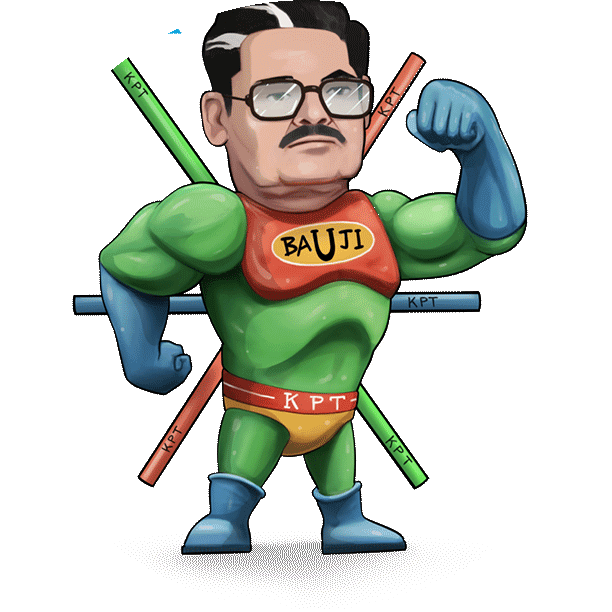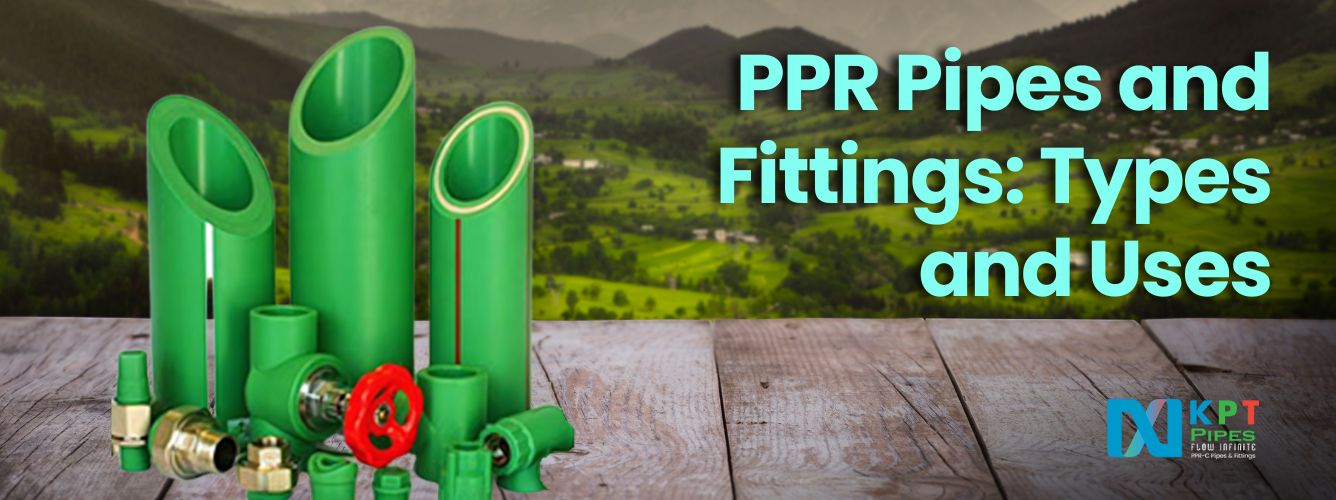PPR pipe and fittings are widely utilized in contemporary plumbing and heating systems because of their outstanding durability, chemical resistance, and easy installation process. These attributes make them a preferred choice for various applications, from residential water supply systems to industrial fluid transportation. This blog delves into the different types of PPR pipes and fittings, highlighting their unique features and specific uses. Whether you’re managing a home renovation, outfitting a commercial building, or operating an industrial facility, understanding the diverse options available in PPR piping can help ensure you select the right products for your needs, guaranteeing efficient and long-lasting performance in your plumbing systems.
Table of Contents
Types of PPR Pipes
- Greentherm Pipes (PPR-C): Designed with improved chemical resistance and higher temperature tolerance, Greentherm pipes are ideal for hot water distribution systems in homes and industrial settings. PPR pipes and fittings guarantee consistent performance and extended lifespan in various environments.
- ThermaPlus Pipes (PPR-FR): These pipes are Flame Retardant (FR), offering enhanced fire safety in buildings where compliance with fire regulations is crucial. They are used in high-rise buildings and industrial facilities to prevent the spread of fire through the plumbing system.
- Pneumatic Pipes: Specifically engineered for air distribution systems with a glass reinforced layer, pneumatic PPR pipes maintain pressure integrity and withstand varying temperatures. They are essential in industrial environments where compressed air is used for machinery and equipment operation.
- PPR-AL-PPR (Composite Pipes): Combining the advantages of PPR with aluminum, these composite pipes offer superior thermal expansion properties and are ideal for compressed air and heating systems. They ensure efficient heat transfer and durability, suitable for both residential and commercial heating applications.
- PPR-CT (Polypropylene Random Copolymer with modified crystallinity and temperature resistance): Known for its high temperature resistance and resistance to harsh chemicals, PPR-CT pipes are used in demanding industrial applications and chemical processing plants. They ensure reliable performance in aggressive environments.
Each type of PPR pipe is selected based on specific requirements such as temperature, pressure, chemical resistance, and environmental conditions, ensuring optimal performance and longevity in plumbing and heating applications.
Types of PPR Fittings
Elbows: Elbows are used to change the direction of the pipe in a plumbing system. They come in various angles, with 90-degree and 45-degree elbows being the most common. These fittings are essential for navigating around obstacles and ensuring the piping system can fit within the desired layout.
Tees: Tees are used to split or combine the flow of water in piping systems. They have a T-shaped design, which allows for the creation of branch lines from the main pipeline. This is crucial for distributing water to multiple locations within a plumbing system, such as in homes and commercial buildings.
Couplings: Couplings are used to connect two pipes together, ensuring a secure and leak-proof connection. They are simple yet vital fittings in any plumbing system, providing a way to extend pipe lengths or repair damaged sections of the pipeline.
Valves: Valves control the flow of water through the piping system. Available in various forms like ball valves and gate valves, each type of PPR pipes and fittings serves distinct functions. Ball valves provide quick shut-off capabilities, while gate valves offer precise flow control, making them essential for maintaining and regulating water flow.
End Caps: End caps are used to seal the end of a pipe, preventing leaks and maintaining pressure within the system. They are crucial for ensuring that the piping system operates efficiently and safely, especially in applications where unused pipe ends need to be securely closed off.
Reducers: Reducers are used to connect pipes of different diameters, helping to manage the flow rate and pressure within the system. They come in various sizes and configurations, allowing for a seamless transition between pipes of different sizes, which is essential for customizing the plumbing system to meet specific needs.
Flanges: Flanges are used to connect pipes to other components, such as valves, pumps, or equipment. They provide a strong and secure connection that can be easily assembled or disassembled, making them ideal for applications that require frequent maintenance or inspection.
Crosses: Crosses have four openings and are used to create multiple branch lines from a single main pipe. They are less common but useful in complex plumbing systems that require the distribution of water to multiple locations.
Caps: Similar to end caps, caps are used to close off the end of a pipe. They can be easily removed if the pipe needs to be extended or modified in the future, providing flexibility in the plumbing system design.
Uses of PPR Pipes and Fittings
PPR (Polypropylene Random Copolymer) pipes and fittings are renowned for their durability, chemical resistance, and ease of installation. These attributes make them ideal for a variety of applications in different sectors. PPR pipes and fittings have the following several significant applications:
Residential Plumbing:
- Water Supply Systems: PPR pipes are extensively used in residential buildings for cold and hot water distribution. Their corrosion resistance and long lifespan make them ideal for domestic plumbing needs.
- Underfloor Heating: In-floor heating systems benefit from PPR pipes due to their ability to withstand high temperatures and pressures.
Commercial Buildings:
- Central Heating Systems: PPR pipes are used in central heating systems of hotels, office buildings, and hospitals, ensuring efficient and reliable heat distribution.
- Chilled Water Systems: For air conditioning and refrigeration, PPR pipes provide an effective solution for transporting chilled water.
Industrial Applications:
- Chemical Transport: PPR pipes resist chemical corrosion, making them suitable for transporting aggressive chemicals and industrial fluids.
- Compressed Air Systems: In industrial settings, pneumatic pipes are used to transport compressed air for machines and equipment.
Agricultural and Irrigation Systems:
- Irrigation: PPR pipes are frequently employed in irrigation systems because of their resilience to the weather and effective crop-watering capabilities.
- Greenhouses: In controlled environments like greenhouses, PPR pipes are used for watering systems and maintaining optimal humidity levels.
Heating Systems:
- Radiator Connections: PPR pipes are used to connect radiators in heating systems, ensuring reliable and efficient heat transfer.
- Boiler Systems: These pipes are suitable for connecting boilers to the heating system due to their high-temperature tolerance.
Environmental Applications:
- Water Treatment Plants: PPR pipes are used in water treatment facilities for their resistance to corrosion and chemical reactions, ensuring clean water supply.
- Wastewater Management: They are also used in wastewater treatment systems for transporting treated water and effluents safely.
Outdoor Plumbing:
- UV-Resistant Applications: UV-resistant PPR pipes are ideal for outdoor plumbing and irrigation systems, as they can withstand prolonged exposure to sunlight without degrading.
- Rainwater Harvesting: These pipes are used in rainwater harvesting systems to collect and transport water efficiently.
Fire Safety Systems:
- Sprinkler Systems: Flame-retardant PPR pipes (ThermaPlus Pipes) are used in fire safety systems to ensure the pipes do not contribute to the spread of fire and maintain integrity during high temperatures.
Health and Safety Applications:
- Healthcare Facilities: PPR pipes are used in hospitals and clinics for delivering potable water due to their hygienic properties and resistance to bacterial growth.
- Laboratories: They are also used in laboratories for transporting various fluids safely and reliably.
Hydronic Piping Systems:
- Heating and Cooling Distribution: PPR pipes are ideal for hydronic piping systems where both heating and cooling water need to be distributed throughout a building, ensuring thermal efficiency and reliability.
The versatility and reliability of PPR pipes and fittings make them an indispensable component in modern plumbing, heating, and industrial systems. By selecting the appropriate type of PPR pipe and fitting, users can ensure optimal performance and longevity in their specific application.
Conclusion
PPR pipes and fittings offer a versatile solution for various plumbing and heating requirements, ensuring efficient water distribution and long-term performance in diverse environments. Whether for residential, commercial, or industrial use, choosing the right type of PPR pipe and fitting ensures reliability, safety, and cost-effectiveness in plumbing systems.



